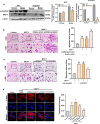β-arrestin2 deficiency ameliorates S-100-induced autoimmune hepatitis in mice by inhibiting infiltration of monocyte-derived macrophage and attenuating hepatocyte apoptosis
- PMID: 37225848
- PMCID: PMC10545685
- DOI: 10.1038/s41401-023-01103-9
β-arrestin2 deficiency ameliorates S-100-induced autoimmune hepatitis in mice by inhibiting infiltration of monocyte-derived macrophage and attenuating hepatocyte apoptosis
Abstract
Autoimmune hepatitis (AIH) is a progressive hepatitis syndrome characterized by high transaminase levels, interface hepatitis, hypergammaglobulinemia, and the presence of autoantibodies. Misdiagnosis or delayed treatment of AIH can lead to cirrhosis or liver failure, which poses a major risk to human health. β-Arrestin2, a key scaffold protein for intracellular signaling pathways, has been found to be involved in many autoimmune diseases such as Sjogren's syndrome and rheumatoid arthritis. However, whether β-arrestin2 plays a role in AIH remains unknown. In the present study, S-100-induced AIH was established in both wild-type mice and β-arrestin2 knockout (Arrb2 KO) mice, and the experiments identified that liver β-arrestin2 expression was gradually increased, and positively correlated to serum ANA, ALT and AST levels during AIH progression. Furthermore, β-arrestin2 deficiency ameliorated hepatic pathological damage, decreased serum autoantibody and inflammatory cytokine levels. β-arrestin2 deficiency also inhibited hepatocyte apoptosis and prevented the infiltration of monocyte-derived macrophages into the damaged liver. In vitro experiments revealed that β-arrestin2 knockdown suppressed the migration and differentiation of THP-1 cells, whereas β-arrestin2 overexpression promoted the migration of THP-1 cells, which was regulated by the activation of the ERK and p38 MAPK pathways. In addition, β-arrestin2 deficiency attenuated TNF-α-induced primary hepatocyte apoptosis by activating the Akt/GSK-3β pathway. These results suggest that β-arrestin2 deficiency ameliorates AIH by inhibiting the migration and differentiation of monocytes, decreasing the infiltration of monocyte-derived macrophages into the liver, thereby reducing inflammatory cytokines-induced hepatocytes apoptosis. Therefore, β-arrestin2 may act as an effective therapeutic target for AIH.
Keywords: MCP-1; TNF-α; autoimmune hepatitis; hepatocyte; macrophage; monocyte; β-arrestin2.
© 2023. The Author(s), under exclusive licence to Shanghai Institute of Materia Medica, Chinese Academy of Sciences and Chinese Pharmacological Society.
Conflict of interest statement
The authors declare no competing interests.
Figures








Similar articles
-
β-arrestin2 depletion attenuates autoimmune hepatitis in mice via preventing intestinal barrier disruption and inhibiting ERS mediated intestinal epithelial cells apoptosis.Biochem Pharmacol. 2025 Oct;240:117129. doi: 10.1016/j.bcp.2025.117129. Epub 2025 Jul 5. Biochem Pharmacol. 2025. PMID: 40623457
-
Vitexin attenuates autoimmune hepatitis in mouse induced by syngeneic liver cytosolic proteins via activation of AMPK/AKT/GSK-3β/Nrf2 pathway.Eur J Pharmacol. 2022 Feb 15;917:174720. doi: 10.1016/j.ejphar.2021.174720. Epub 2021 Dec 23. Eur J Pharmacol. 2022. PMID: 34953801
-
Monocyte-derived macrophages contribute to the deterioration of immunological liver injury in mice.Int Immunopharmacol. 2023 Nov;124(Pt B):111036. doi: 10.1016/j.intimp.2023.111036. Epub 2023 Oct 11. Int Immunopharmacol. 2023. PMID: 37832236
-
Autoimmune diseases of the liver and biliary tract and overlap syndromes in childhood.Minerva Gastroenterol Dietol. 2009 Mar;55(1):53-70. Minerva Gastroenterol Dietol. 2009. PMID: 19212308 Review.
-
[Autoimmune hepatitis and overlap syndrome: diagnosis].Praxis (Bern 1994). 2002 Aug 21;91(34):1339-46. doi: 10.1024/0369-8394.91.34.1339. Praxis (Bern 1994). 2002. PMID: 12233264 Review. German.
Cited by
-
FGF4 ameliorates the liver inflammation by reducing M1 macrophage polarization in experimental autoimmune hepatitis.J Transl Med. 2024 Aug 2;22(1):717. doi: 10.1186/s12967-024-05219-2. J Transl Med. 2024. PMID: 39095789 Free PMC article.
-
Deficiency of β-arrestin2 ameliorates MASLD in mice by promoting the activation of TAK1/AMPK signaling.Arch Pharm Res. 2025 May;48(5):384-403. doi: 10.1007/s12272-025-01544-2. Epub 2025 May 8. Arch Pharm Res. 2025. PMID: 40341987
-
β-arrestin2: an emerging player and potential therapeutic target in inflammatory immune diseases.Acta Pharmacol Sin. 2025 Sep;46(9):2347-2362. doi: 10.1038/s41401-024-01390-w. Epub 2024 Sep 30. Acta Pharmacol Sin. 2025. PMID: 39349766 Review.
-
Curdlan-Decorated Fullerenes Mitigate Immune-Mediated Hepatic Injury for Autoimmune Hepatitis Therapeutics via Reducing Macrophage Infiltration.ACS Appl Mater Interfaces. 2024 Feb 7;16(5):5536-5547. doi: 10.1021/acsami.3c16168. Epub 2024 Jan 24. ACS Appl Mater Interfaces. 2024. PMID: 38267397 Free PMC article.
References
MeSH terms
Substances
LinkOut - more resources
Full Text Sources
Other Literature Sources
Medical
Research Materials
Miscellaneous

